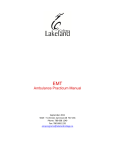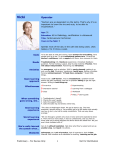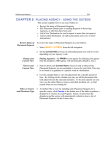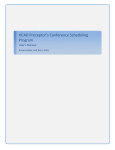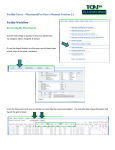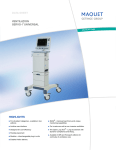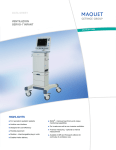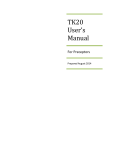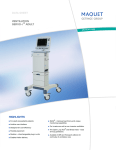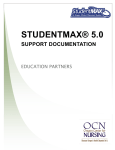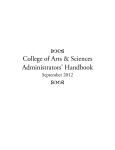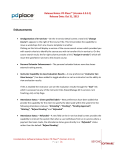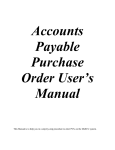Download Is the EMT Ambulance Practicum Complete?
Transcript
EMT Ambulance Practicum Manual January 2013 5025 – 51 Street, Camrose AB T4V 1S6 Phone: 780 608 1240 Fax: 780 608 1235 [email protected] SUPPORT Academic Support Require a code: Call 780 608 1240 during office hours, or email [email protected] any time and ask for a preceptor code. You must supply preceptor name, name of facility/service, name of student, and a contact phone number and/or email. A student cannot request a preceptor code. When the student starts: Ensure the Student Contract in the front of this manual is filled in and faxed to the number indicated on the form. When the student is done: See the Practicum Completion Checklist at www.lakelandcollege.ca/emspracticums Phone: Call 780 608 1240, or call 1-800-661-6490 and follow the directions to be connected to the Camrose office. After-hours messages will receive replies the next business day. Email: [email protected] Preceptor Support Website: www.lakelandcollege.ca/emspracticums Online Logbook: lakelandlogbook.com Technical Support Phone 780 608 1240, or email [email protected]. ©Lakeland College, 2013 IMPORTANT!! The preceptor MUST call 780 608 1240 (during office hours) or email [email protected] to obtain a preceptor code before proceeding with the practicum. The contract following this page or at www.lakelandcollege.ca/emspracticums must be signed and submitted on the first shift. The Preceptor must read the contents of this manual and view the preceptor presentation found at www.lakelandcollege.ca/emspracticums Table of Contents EMT Ambulance Practicum Manual Academic and Technical Supports IMPORTANT! Table of Contents Student Practicum Contracts Forms: Ambulance Practicum Completion Checklist Ambulance Exposure Practicum Evaluation Form Ambulance Midpoint Evaluation Form Ambulance Final Evaluation Form Resource Evaluation Form Preceptor Program Evaluation Form Patient Care Report Form (Print copies for practice – optional) Employer Survey (Requested whenever possible) Logbook Instructions Frequently Asked Questions Practicums and Program Approvals Preceptor Expectations of Lakeland College Lakeland College Expectations of Preceptors EMT Ambulance Exposure Practicum Goals How to Use the Logbook Requirements for Students on Practicum Practicum Safety Policies and Protocols Poisons Other Resources Available Lakeland’s EMS Programs Policies and Safety Procedures Handbook Evaluation Forms found at www.lakelandcollege.ca/emspracticums Ambulance Practicum Completion Checklist Ambulance Exposure Practicum Evaluation Form Ambulance Midpoint Evaluation Form Ambulance Final Evaluation Form Resource Evaluation Form Preceptor Program Evaluation Form Patient Care Report Form (Print copies for practice – optional) Call Competency Integration Form (For practice – optional) Employer Survey (Requested whenever possible) Preceptor Resources: www.lakelandcollege.ca/emspracticums EMT Ambulance Practicum Contracts At the beginning of each placement, sign one contract and fax immediately to 780-608-1235. Lakeland College EMT Ambulance Practicum Manual ©2013 Complete this page before beginning practicum. Fax to 780 608 1235. EMT PROGRAM Practicum Contract – Ambulance Exposure Practicum As soon as this contract is signed, it must be faxed to 780 608 1235 Please Print Student Name: ____________________________ Address: ____________________________ Phone: ____________________________ Practicum Service or Hospital: ________________ Preceptor Name: ____________________________ Practicum Schedule: (Please includes dates and times for all shifts scheduled with this preceptor) I have read the above-listed practicum schedule and agree to attend my practicum shifts as outlined above. If I should need to make changes to this schedule or be absent from any of these shifts for any reason, I will contact both my practicum preceptor, and my school in advance. ____________________________ EMT Student Signature ____________________________ Practicum Supervisor ____________________________ Date As soon as this contract is signed, it must be faxed to the school at 780 608 1235 Lakeland College EMT Ambulance Practicum Manual ©2013 Complete this page before beginning practicum. Fax to 780 608 1235. EMT PROGRAM Practicum Contract – Ambulance Experience As soon as this contract is signed, it must be faxed to 780 608 1235 Please Print Student Name: ____________________________ Address: ____________________________ Phone: ____________________________ Practicum Service or Hospital: ________________ Preceptor Name: ____________________________ Practicum Schedule: (Please includes dates and times for all shifts scheduled with this preceptor) I have read the above-listed practicum schedule and agree to attend my practicum shifts as outlined above. If I should need to make changes to this schedule or be absent from any of these shifts for any reason, I will contact both my practicum preceptor, and my school in advance. ____________________________ EMT Student Signature ____________________________ Practicum Supervisor ____________________________ Date As soon as this contract is signed, it must be faxed to the school at 780 608 1235 Lakeland College EMT Ambulance Practicum Manual ©2013 Forms Lakeland College EMT Ambulance Practicum Manual ©2013 EMT Ambulance Practicum Completion Checklist Is the EMT Ambulance Exposure Experience Complete? □ □ Assigned hours complete Evaluation forms completed Is the EMT Ambulance Practicum Complete? Beginning of Practicum □ Practicum schedule contract faxed to school (on initial shift) Halfway Through Practicum □ EMT Ambulance Midpoint Practicum evaluation form Final □ □ □ □ □ □ Minimum 240 hours completed (see list of competencies for requirements) and attended a minimum of 25 patients. Interhospital transfers do not count towards minimums. All required competencies completed Final Ambulance Practicum evaluation completed Resource Evaluation completed Program Evaluation by Preceptor completed. If you require clarification or have any questions, please contact the school at 780 608 1240. Preceptor Evaluation by Student (Distributed in eCampus) All forms are available at www.lakelandcollege.ca/emspracticums All forms should be faxed to 780 608 1235 immediately upon completion. Lakeland College EMT Ambulance Practicum Manual ©2013 Lakeland College EMT Ambulance Exposure Placement Preceptor Evaluation of Student EMT Supervisor/Preceptor (print)__________________________________________ Name of Service _________________________________________________________ Student Name (print)______________________________________________________ Please rate the student's overall performance on the Exposure Placement, with 1 being lowest, and 5 being highest. 1. Very Poor – unsuccessful on all aspects of calls. 2. Poor – unsuccessful on some aspects of calls. 3. Fair – requires some supervision and some intervention. 4. Good – requires minimal supervision and no intervention. 5. Excellent – requires no supervision. Evaluation 1. Interaction with patient, family members hospital & EMS staff Comments: 2. Familiarization with equipment Comments: 3. Patient assessment (eg. Primary, secondary and ongoing) Comments: 4. Treatment appropriate to call Comments: 5. Report to receiving facility Comments: 6. Call management Comments: 7. Patient care report documentation Comments: Lakeland College EMT Ambulance Practicum Manual ©2013 1 2 3 4 5 Preceptor comments: 1. What is the preceptor’s evaluation of the student’s strengths? 2. Identify any skills that need improvement. 3. What is the preceptor view of overall patient care? 4. In your opinion, is the student ready in skills, attitudes, knowledge and proficiency to advance to a final EMT ambulance practicum? Please comment. 5. What is the student’s view of the practicum at this point? Further Comments: Preceptor Signature: _______________________________________________________ Student Signature: ________________________________________________________ Date: ___________________________________________________________________ Return only these two pages by fax to 780 608 1235 immediately upon the conclusion of the EMT Ambulance Exposure Practicum. Lakeland College EMT Ambulance Practicum Manual ©2013 EMT Ambulance Midpoint Practicum Evaluation EMT Supervisor/Preceptor (print)__________________________________________ Name of Service _________________________________________________________ Student Name (print)______________________________________________________ 1. What is the preceptor’s evaluation of the student’s strengths? 2. Identify any skills that need improvement. 3. What is the preceptor view of overall patient care? 4. Is the student at the expected level of proficiency given this stage of the practicum? Comments? 5. What is the student’s view of the practicum at this point? Further Comments: Preceptor Signature: _______________________________________________________ Student Signature: ________________________________________________________ Date: ___________________________________________________________________ Return this form by fax to 780 608 1235 immediately at the midpoint of the practicum. Lakeland College EMT Ambulance Practicum Manual ©2013 EMT Final Ambulance Practicum Evaluation EMT Supervisor/Preceptor (print)__________________________________________ Name of Service _________________________________________________________ Student Name (print)______________________________________________________ Agree Disagree Student takes appropriate safety precautions Student establishes adequate patient communication Student is able to work collaboratively with EMS staff Student shows initiative Student is able to make critical interventions where Necessary Student accepts and delivers constructive feedback Student displays a learning attitude Student uses appropriate language/actions with patients and staff Student demonstrates problem solving skills and prudent judgement Student communicates reports in properly written and verbal form Student maintains patient confidentiality Student maintains patient dignity Student abides by schedule as set by EMS Service Student dresses appropriately and maintains personal hygiene Student functions within the scope of practice as an EMT The Student performed all skills and competencies necessary to successfully complete this practicum. Comments: Preceptor Signature _______________________________________________ Page 1 of 2 Lakeland College EMT Ambulance Practicum Manual ©2013 EMT Final Ambulance Practicum Evaluation Page 2 To be filled out by the Preceptor Is the student at the expected level of proficiency for a graduate EMT? Are there any skills that still need improvement prior to graduation? Is additional practicum time required for successful completion of the practicum? Further Comments: Preceptor Signature: _______________________________________________________ Student Signature: ________________________________________________________ Date: ___________________________________________________________________ Return this form by fax to 780 608 1235 immediately Lakeland College EMT Ambulance Practicum Manual ©2013 Resource Evaluation Form To be completed by the preceptor 1. Did your student show you the preceptor support website? □ Yes □ No 2. Did your student orient you to the electronic logbook? □ Yes □ No □ Not Applicable 3. Did you review the online 4. Preceptor Training Presentation? □ Yes □ No Practicum Manual? □ Yes □ No Did you find the online resources and downloadable files from the preceptor support website easy to access? □ Yes □ No Did you find the online resources easy to use? □ Yes □ No Did you find the electronic logbook easy to use? □ Yes □ No □ Not Applicable Comments: 5. If you had questions, either print, electronic, or technical, did you have any difficulty contacting Lakeland’s EMS program staff,? □ Yes □ No If yes, please provide details: 6. Keeping in mind the requirements made of us by accreditation, what changes would you recommend for our preceptor resources or supports? 7. Other comments (Please use the back of this sheet if necessary) Fax this form to (780) 608-1235 with all other practicum evaluation forms Lakeland College EMT Ambulance Practicum Manual ©2013 EMT Program Evaluation by Preceptor The Lakeland EMT Program offers education at the Primary Care Paramedic competency level as defined by the National Occupational Competency Profile. With that framework in mind, please answer the following as thoroughly as possible. Please feel free to comment on any aspect of the survey. 1. In what year did you precept a Lakeland student? 2. How many EMT students from Lakeland have you precepted? 3. Are you familiar with the National Occupational Competency Profile developed by the Paramedic Association of Canada for a Primary Care Paramedic? Yes 4a. No In your opinion, are the students that you determine to be at a graduate level competent at the Primary Care Paramedic as outlined in the National Occupational Profile? Yes No 4.b Have you observed that a student who graduates from your preceptorship is able to perform the following competencies: Yes No Don’t Know 1.6.c Integrate task delegation. (Ambulance) 3.2.d Integrate safe and secure measures for patient transport. (Ambulance) 4.2.f Integrate incident information into assessment. (Ambulance) 4.4.i Apply the Glasgow Coma Scale (GCS) to mental status assessment. Assess level of mentation. (Ambulance) 5.4 a Provide ventilation using bag-valve mask. (Hospital) 5.5.d Perform peripheral IV cannulation. (Ambulance) 6.1 k Provide care to patient experiencing illness or injury do to poisoning or overdose. (Ambulance) Comments: Lakeland College EMT Ambulance Practicum Manual ©2013 5. On a scale from Strongly Disagree to Strongly Agree, how would you rate the experience you had with precepting a Lakeland student? Strongly Disagree Neutral Agree Strongly Don’t Disagree Agree Know Our onsite practicum coordinator was initially contacted in an appropriate manner by the school. My student oriented me to the online Practicum Manual. I read the Practicum Manual and discussed its content with the student. My student told me how to access to the school. Comments: 6. On a scale from Strongly Disagree to Strongly Agree, have you found that our program has prepared a Lakeland EMT graduate to be: Strongly Disagree Neutral Agree Strongly Don’t Disagree Agree Know Competent at a Primary Care Paramedic Level. Well-prepared for employment as an EMT. Well-prepared for Alberta College of Paramedics exams. Committed to lifelong learning and professional development. An advocate for academic advancement in EMS. An advocate for technical advancement in EMS. An advocate for research in EMS. A positive representative of his/her school. One who makes positive contributions to his/her EMS service. Comments: Lakeland College EMT Ambulance Practicum Manual ©2013 7. Please use the space following to discuss what you believe to be the strengths/weaknesses of this program: 8. Please use the space following to address any further comments and recommendations you may have regarding the Lakeland EMT program: Your Name (please print): ________________________________________ Date: __________________________________________________________________ Please return this survey by email to: [email protected] Or by fax to 780 608-1235 Lakeland College EMT Ambulance Practicum Manual ©2013 Lakeland College EMS Programs (for practice if desired) *PATIENT CARE REPORT Date: Call Number: Patient Complaint/Reason for Ambulance Time Pulse Blood Pressure Resp. Weight GCS PHI Skin Pupils Medic Alert Y O2 Sat. Allergies Y N N For: Unknown Medications (List) History and Treatment __________________________________ Preceptor Name (please print) __________________________________ Preceptor Signature __________________________________ Student Name (please print) __________________________________ Student Signature __________________________________ Date *This Patient Care Report is for educational purposes only, and does not constitute a legal document. Lakeland College EMT Ambulance Practicum Manual ©2013 Lakeland College EMT Program Program Evaluation by Employer The Lakeland EMT Program offers education at the Primary Care Paramedic competency level as defined by the National Occupational Competency Profile. Please answer the following as thoroughly as possible and comment on any aspect of the survey. 1. How many students currently attending the Lakeland EMT Program do you employ? 2. How many graduates from the Lakeland EMT Program do you currently employ? 3. Are you familiar with the National Occupational Competency Profile developed by the Paramedic Association of Canada for a Primary Care Paramedic? Yes □ No □ 4.a In your opinion, are your Lakeland graduate employee(s) competent at the Primary Care Paramedic as outlined in the National Occupational Profile? Yes □ No □ N/A □ Comments: 4.b Have you observed that a graduate from the Lakeland EMT program is able to perform the following competencies? Yes 1.6.c Integrate task delegation. (Ambulance) 3.2.d Integrate safe and secure measures for patient transport. (Ambulance) 4.2.f Integrate incident information into assessment. (Ambulance) 4.4.i Apply the Glasgow Coma Scale (GCS) to mental status assessment. Assess level of mentation. 5.4 a Provide ventilation using bag-valve mask. 5.5.d Perform peripheral IV cannulation. 6.1 k Provide care to patient experiencing illness or injury do to poisoning or overdose. (Ambulance) Comments: Lakeland College EMT Ambulance Practicum Manual ©2013 No Don’t Know 5. On a scale from Strongly Disagree to Strongly Agree, how would you rate the experience your service had with precepting a Lakeland student? Strongly Disagree Disagree Neutral Agree Strongly Agree Don’t Know Our onsite EMS service Practicum Coordinator was initially contacted in an appropriate manner by the school. A practicum contract was in place with our service for the student’s placement. Our employee/preceptor received orientation to the online Practicum Manual by his/her student. Our employee/preceptor read the online Practicum Manual and discussed its content with the student. Our employee/preceptor had adequate access to the school. Comments: 6. On a scale from Strongly Disagree to Strongly Agree, have you found that our program has prepared a Lakeland EMT graduate to be: Strongly Disagree Competent at an Primary Care Paramedic Level. Well-prepared for employment as an EMT. Well-prepared for Alberta College of Paramedics exams. Committed to lifelong learning and professional development. An advocate for academic advancement in EMS. An advocate for technical advancement in EMS. An advocate for research in EMS. A positive representative of his/her school. One who makes positive contributions to his/her EMS service. Comments: Lakeland College EMT Ambulance Practicum Manual ©2013 Disagree Neutral Agree Strongly Agree Don’t Know 7. Please use the space following to discuss what you believe to be the strengths/weaknesses of this program: 8. Please use the space following to address any further comments and recommendations you may have regarding the Lakeland EMT program: Your Name (please print): ____________________________________________________ Date: __________________________________________________________________ Please return this survey by email to: [email protected] Or by fax to 780 679 1577 Lakeland College EMT Ambulance Practicum Manual ©2013 Lakeland College EMT Ambulance Practicum Logbook Instructions Lakeland College EMT Ambulance Practicum Manual ©2013 Frequently Asked Questions Is the Lakeland EMT Program CMA Accredited? The Lakeland College EMT program has approval from the Alberta College of Paramedics, as indicated on the ACP Program Approvals website and a two-year CMA accreditation. Application to extend the two years to six years will be made to the CMA in spring 2014. CMA program status for all programs is found at www.cma.ca/accredit How many hours are required on the Lakeland EMT Ambulance Practicum? While a competency-based experience emphasizes competency and not time, it is still true that over a period of time, competency improves. Students must complete all competencies in the required setting to meet graduation requirements. However, it is helpful for preceptors and administrators to have an idea of roughly how long it takes to complete a practicum. An EMT Ambulance Exposure Practicum requires students to complete a minimum of 40-48 hours on car, with no competencies assessed. An EMT Ambulance Practicum requires students to have a minimum of 25 calls or patients. Inter-hospital transfers do not count towards this minimum. The minimum time requirement for the Ambulance Practicum is 240 hours regardless of what competencies have been completed. The actual number of hours required to complete the competencies could be greater or less than this. Canadian Medical Association requires that practicums are competency-based. We believe that every student requires a minimum number of hours to grow familiar with the EMT scope of practice, but the completion of competencies in their required settings is a mandatory requirement for completion of a practicum and maintenance of accreditation. When all competencies in the Primary Care Paramedic profile are met, the practicum is complete. How are practicum hours counted? Typically, a student may only count the hours worked on shift, up to 10 hours per shift. However, some exceptions may apply. Example #1: If the preceptor is paid $15 per hour for each hour of a 24-hour period, then all 24 hours will count towards practicum hours. Example #2: If the preceptor’s daily wage is based on only 10 hours at $15 per hour, then only 10 hours will count towards practicum. Any overtime hours will count towards practicum (1 hour of overtime equals 1 hour of practicum time). The exception to this is continuous practicum sites where housing is provided by the site and where the student is expected to take lead on every call, within reason. These sites are specifically identified by practicum coordinators. The student is then allowed to count every hour towards practicum. Students are required to self-monitor for fatigue, and to take necessary rest breaks to ensure adequate performance and patient safety. In situations where the site is exceptionally busy, Lakeland College EMT Ambulance Practicum Manual ©2013 the student is expected to remove himself/herself from active service and take an 8-hour break to avoid fatigue. Do simulation competencies have to be completed? No - All simulations will be completed in the classroom prior to placement in a practicum setting. Do all competencies have to be completed? Yes, although some competencies may be extremely difficult to complete. If your service is unlikely to experience some of the competencies in the profile, the preceptor and the student should be contacting the school for assistance. All required competencies must be successfully completed a minimum of twice. You can find a list of the required competencies at www.lakelandcollege.ca/emspracticums How does the preceptor contact the school, or get the school to contact the preceptor? For contact information, see the “Contact Us” sheet (2nd page of this logbook), or go to www.lakelandlogbook.com and view the “Contact Us” information. It is critical that the contract at the front of this book be faxed to the school on the first shift, and that the preceptor informs the school if a contact is requested. Additional contracts may be found on the website. How do I receive training to be a Lakeland preceptor, and how will the school support me? Every Lakeland College preceptor needs to view the Preceptor resources found on the website in order to understand the Lakeland educational philosophy and what is required of preceptors. Preceptors are able to contact the school by phone, fax, or email. Practicum visits by Lakeland staff will vary, but we will try to visit twice during the practicum. If the preceptor indicates that he/she wants a practicum visit, let the Lakeland practicum supervisor know as soon as possible. One or two instructors will be assigned to the practicum, and they will do the practicum visits; it will not always be the practicum supervisor. At times, we are not informed that a student has begun a practicum, so do not hesitate to request a visit or a contact from us at any time. The preceptor support website contains a wealth of information about EMS, innovations in EMS and medicine, hot topic links and information about Lakeland, and is found at www.lakelandcollege.ca/emspracticums Lakeland College EMT Ambulance Practicum Manual ©2013 Can the preceptor’s Online Logbook Preceptor Code be shared with other preceptors? Preceptor Codes are assigned to preceptors, and not connected to student names. Therefore, when a preceptor uses a code, the school will know what competencies that particular preceptor marked. A preceptor may choose to share a code, but only if he or she is willing to take responsibility for the competencies marked by the second person using the code, and is able to answer questions about that marking, if the school should need to verify data. How do I define competence? Competence involves the demonstration of skills, knowledge and abilities in accordance with the following principles: consistency (the ability to repeat practice techniques and outcomes) independence (the ability to practice without assistance from others) timelines (the ability to practice in a time frame that enhances patient safety) accuracy (the ability to practice utilizing correct techniques and to achieve the intended outcomes) appropriateness (the ability to practice in accordance with clinical standards and protocols outlined within the practice jurisdiction) Lakeland College EMT Ambulance Practicum Manual ©2013 Practicums and Program Approvals The EMT and Paramedic Programs at Lakeland College must remain in compliance with Alberta College of Paramedic (ACP) Program Approval standards, as well as the Canadian Medical Association accreditation standards. It is the commitment of Lakeland College to maintain all required program approvals and accreditation. As is required, Lakeland College maintain program approval for each of its EMS programs with ACP. These program approvals will be renewed on the schedules as are determined by ACP. The Lakeland College EMS programs have approval from the Alberta College of Paramedics, as indicated on the ACP Program Approvals website . The Alberta College of Paramedics also currently mandates that all EMT and Paramedic training programs within the province of Alberta seek and maintain CMA accreditation. The Lakeland College EMS programs hold 2 year CMA accreditations, and application to extend the two years to six years will be made to the CMA in spring 2014. CMA program status for all programs is found at www.cma.ca/accredit In Canada, the Paramedic Association of Canada (PAC) is currently the body which defines a national occupational competency profile (NOCP) for EMS. The current profile can be viewed at http://www.paramedic.ca. (click on Initiatives). Further information about the Paramedic Association of Canada can also be viewed on this site. Additionally, the Alberta College of Paramedic determines scope of practice in the province, and this information is available at www.collegeofparamedics.org To ensure compliance with current requirements, practicums are competency driven. A complete copy of the Primary Care Paramedic list of competencies by which our students are assessed is provided in the online logbook, as well as in our preceptor resources. These competencies are divided by the settings in which they are assessed, including ambulance field preceptorship, hospital clinical preceptorship, simulation and didactic evaluation. As an ambulance preceptor, you will be involved only in the ambulance competencies that are outlined for you in the Online Logbook. Lakeland College EMT Ambulance Practicum Manual ©2013 Preceptor Expectations of Lakeland College What You Can Expect from Lakeland College What the preceptor should expect Expect to spend time documenting student performance on a daily basis. Expect to see a number of innovations as schools attempt to make the assessment process as straightforward as possible. Our online Logbook is the first of its kind in Alberta’s EMS training. Expect to find support and assistance from Lakeland. A number of support systems are in place for our preceptors. More information on the supports that will be available to you is outlined in the following pages. Along with this Preceptor Training Manual, you will receive a variety of resources to assist you in precepting a Lakeland Student. A brief description of each of these resources and how they may be used follows. 1. Practicum Student Contract At Lakeland, we take your commitment of time and energy to our student seriously, and it is important to us that students do not abuse the time given to them by their preceptors. Prior to you being assigned a student, we will have signed a practicum contract with your service verifying that insurance and liability issues have been addressed. At the front of this print logbook, you will find a Student Practicum Contract which should be completed on or before the first shift. When you and your student agree on the shift schedule for the practicum experience, please take a moment to complete the Student Practicum Contract, have the student sign it, and fax it back to us at 780 608 1235 or mail it back to us for our records. This serves two purposes: 1) it reinforces to the student the importance of honouring the schedule as it is presented; and 2) it allows us to track our students so that we are able to schedule on-site visits and check in with you approximately half-way through the practicum. It is extremely important in coordinating our practicum visits that this information be inserted into the Online Logbook as well. Additional contracts may be found at www.lakelandcollege.ca/emspracticums 2. Instructions on How to Use the Logbook Included in this manual are instructions on how to use the forms and the electronic logbook. Along with those instructions, you will find a Users Manual for the Online Logbook, objectives for the practicum (Objectives for Practicum), as well as statements about our approach to the various policies and protocols presented to our students by their preceptors. 3. Preceptor Training Presentation and Other Supports A presentation on preceptorship, competency, educational philosophy, educational psychology and educational foundations is available at www.lakelandcollege.ca/emspracticums. You should view the presentations and keep these principles in mind as you work with your student. A number of other supports are also available for the preceptor at this website. 4. Paper Forms There are two parts to documenting the practicum experience: printed forms and an Online Logbook. Much of the day-to-day documentation required of you will be done using the Online Logbook. However, there are a few details which still need to be recorded by hand, including signatures and forms which are best documented on paper. Please take time to sit down with your student before or at the beginning of your first shift together to review these materials together, so that you are in agreement regarding the completion of practicum requirements. More detailed information is found in the section entitled “How To Use the Logbook” found in this manual. If you still have problems, use any of the applicable supports listed on the inside front cover of this manual. 5. Online Logbook Lakeland is pleased to be using a unique Online Logbook, designed with the time constraints of the preceptor in mind. You and your student will need to diligently log your calls using the Online Logbook. We recommend that your student submits documentation for each call as soon as it is complete. If that is not possible, the student needs to document the shift before leaving for the day. We also urge you to accept or reject student submissions as soon as possible after they are submitted. Timely collection of this data will be the difference between success and frustration for both you and your student. Attendance at practicum is monitored according to the shift schedule as it is presented through the Online Logbook, and faxed to our office on the first shift. It is the student’s responsibility to record competencies and shift changes in the Online Logbook on a daily basis (or as quickly as possible after each shift). No data may be graded until it is stored on our website, where it is securely saved and backed up regularly. The student will have to repeat assessment of all unsubmitted competencies. If the student fails to update data to the Online Logbook within a reasonable time frame, then the student will be considered to have failed the practicum. Should you have any further questions on using the logbook or on your preceptorship in general, you should feel free to contact us by phone 780 608 1240. 6. Phone number and other Supports There can be times when you need to speak with someone for clarification on a particular point. Voice mail is also available 24/7. Your call is important to us, and will be returned shortly by someone who is able to answer your questions. You are welcome to phone 780 608 1240 any time you need to and leave your message. This number will reach our administrative staff during normal office hours and voice mail after that. 7. Site Visits Program staff have made the commitment to visit our students on site when possible. If at any time you feel that a site visit is required, you should call our toll free number and make that request. 8. Student Attire Preceptors should expect Lakeland students to wear proper attire and identification while on practicum. Students are provided with identification tags which should be displayed at all times. EMT students are required to purchase uniforms for their in-class training which they may also wear on practicum, but they should dress as directed by the guidelines of your service. 9. Using the Online Logbook A copy of the User Manual for the Online Logbook is supplied with this manual. Both the student and the preceptor are required to have access to the internet. Both the preceptor and the student are issued unique codes which must be entered by program staff into the website to activate a practicum. It is the student’s responsibility to enter the data; it is the preceptor’s responsibility to grade student submissions. In order to enter data, a preceptor code must be entered. To ensure the integrity of preceptor grading, the student will not know the preceptor code. In order to obtain the code, you as the preceptor must phone Lakeland (780 608 1240) during business hours (0830 to 1630 hrs) or email [email protected]. A username and password will then be given to you. During this contact, you will also be requested to supply your name and contact information for our practicum records and you will be given opportunity to ask any further questions. You must not reveal your username or password to the student. Students are informed that if they become aware of a preceptor password they are to immediately inform Lakeland so that the password can be changed. You may also acquire your preceptor password by emailing [email protected] any time after your student has been assigned to you. Once you as a preceptor are given access to the Online Logbook, visit www.lakelandlogbook.com., and click on “Log in.” Enter your username and password that were provided to you. The Home Page of the logbook allows you to view the Paramedic program Competency Profile in its entirety. As an Ambulance preceptor, you are required to assist the student in completing all Ambulance and simulation competencies. If your student has submitted competencies to you, you will be able to view them from your Home Page. If you do not have a message indicating that competencies have been submitted, you need to discuss the timely submission of competencies with your student. If there are any difficulties, please contact the school. When competencies are submitted, you are able to click on the submission, view the care report and the competencies completed on the call, verify any data that needs to be checked, make comments, and either reject or accept the call. All competencies must be successfully completed a minimum of twice. If you Accept the call, all competencies completed on that call are reduced on the student’s list of requirements. If you Reject the call, all competencies completed on that call are rejected and the student is required to re-submit the competencies either by re-submitting the call, or by completing them on a new call. All Rejected calls require comments. 10. Preceptor Webview of Competencies Assessed Preceptors may also view progress of their students by viewing the student’s view on the Online Logbook website at www.lakelandlogbook.com. Due to privacy rights, access to this view is given by the student. Preceptors are encouraged to view and discuss the student’s progress on a regular, preferably daily basis. Ambulance preceptors are required to complete all forms required on the Practicum Completion Checklist found at www.lakelandcollege.ca/emspracticums 11. Student Approach to Learning Your student has been strongly urged to actively seek out learning opportunities. We believe that students who find themselves idle should then turn to their studies, or be given learning opportunities by their preceptors. 12. A Commitment to Safety You will find a copy of the Practicum Safety Policies including all required forms online at www.lakelandcollege.ca/emspracticums. Should an incident occur requiring that a safety report be logged, the student and preceptor should follow the preceptor’s safety protocols and procedures first. They then should complete the Lakeland Incident and contact the Health Safety Office within 24 hours of the incident. To report an incident and initiate paperwork, fill out the Incident Report Form found in the EMS Programs Policy and Safety Procedures Manual, Appendix D (or call the office at 780 608 1240 for a form), and then contact the Health Services office at Telephone: 1 800 661 6490 (ext 8432) or 780 853 8432 Fax: 780 853 8706 Incidents must be reported as soon as possible, and no later than 24 hours from the incident. Lakeland College Expectations of Preceptors What Lakeland College Expects from You What do we expect from our preceptors? 1. We expect that you will spend adequate time with our student to document all competencies practiced and completed. You will need to use the tools provided to you on a regular basis so that we are able to appropriately measure student success. 2. We expect that you will read this manual and view the Preceptor Training Presentation at www.lakelandcollege.ca/emspracticums 3. We expect that you will intercede when a student is unable to perform a competency, and that patient care will always come first. 4. As an ambulance preceptor, you are required to complete the competencies presented in the “Ambulance” portion of the Online Logbook. 5. The ambulance preceptor must be, at minimum a registered EMT (Primary Care Paramedic) or equivalent with 3 years or more experience. Ideally, the ambulance preceptor will be a registered Paramedic (Advanced Care Paramedic) preferably with 3 years or more experience. 6. We expect that all evaluations will be done by you and that you will not divulge your preceptor access code to either the student or anyone else (see the FAQ sheet on sharing a code). 7. We expect that once competence in a given procedure or skill is achieved, the student will still be supervised by the ambulance preceptor. However, the supervision may be indirect provided that the preceptor is nearby and in a position to immediately assist the student if required. 8. We expect that in an ambulance practicum, the student will be oriented to the ambulance service and all equipment and staff as required. 9. Keeping in mind that Lakeland has the final say in whether a student passes or does not pass the practicum, we expect that you will not recommend a “pass” until the student has completed every required competency in the appropriate setting. All forms must also be completed. 10. When the Student Has Completed All Required Competencies You and your student complete all evaluation forms found on the website link at the Online Logbook website, or go to www.lakelandcollege.ca/emspracticums. Ensure that all paperwork is completed, and submit the paperwork by fax or mail to the school for evaluation. 11. We expect that you will do the following: Direct learning activities Validate learning activities Document positive and negative progress Evaluate progress 12. We expect that you will feel free to take advantage of the preceptor supports we offer. See the inside front cover of this manual for contact information. EMT Ambulance Exposure Practicum Goals Primary Course Goals 1. To ensure ambulance experience is obtained 2. To expose the student to different clinical case presentations as might occur on an ambulance 3. To provide the student with the opportunity to integrate theory with practice 4. To develop an accumulation of example cases for future reference 5. To increase student confidence in an EMT ambulance practicum setting 6. To expose the student to the clinical skill, assessment, treatment, and ambulance call management for the EMT scope of practice. General Course Goals Upon successful completion of this course, students will be able to: 1. take safety precautions 2. establish adequate patient communication 3. work collaboratively with ambulance and hospital staff 4. begin to show initiative 5. begin to make critical interventions 6. deliver and accept constructive feedback 7. display a learning attitude 8. use appropriate language/actions with ambulance and hospital staff 9. begin to demonstrate problem solving skills and prudent judgment 10. begin to communicate reports in properly written and verbal form 11. maintain patient dignity and confidentiality 12. abide by a schedule set by ambulance staff 13. dress appropriately and maintain personal hygiene 14. function within the scope of practice 15. perform increasingly complex skills and competencies under direct supervision, as the preceptor and student are comfortable 16. demonstrate readiness in skill, comprehension, knowledge and ability for a final EMT ambulance practicum 17. seek out opportunities to practice PCR writing. 18. actively seek out and participate in learning opportunities as opportunities present themselves in the ambulance setting. 19. perform all work under the direct supervision of a designated EMT preceptor. 20. ensure that all required paperwork, including contracts and evaluations forms, are completed and submitted to the school at the appropriate time and in the appropriate format. 21. upon completion of the practicum, the student shall function at the level of an EMT student ready for a final EMT ambulance practicum. 22. Practice techniques for lifting and using a stretcher. EMT Ambulance Practicum Goals Primary Course Goals 1. To ensure ambulance experience is obtained 2. To expose the student to different clinical case presentations as might occur on an ambulance 3. To provide the student with the opportunity to integrate theory with practice 4. To develop an accumulation of example cases for future reference 5. To hone clinical skill, assessment, treatment, and ambulance call management General Course Goals Upon successful completion of this course, students will be able to: 1. take safety precautions 2. establish adequate patient communication 3. work collaboratively with ambulance and hospital staff 4. show initiative 5. make critical interventions 6. deliver and accept constructive feedback 7. display a learning attitude 8. use appropriate language/actions with ambulance and hospital staff 9. demonstrate problem solving skills and prudent judgment 10. communicate reports in properly written and verbal form 11. maintains patient dignity and confidentiality 12. abide by a schedule set by ambulance staff 13. dress appropriately and maintain personal hygiene 14. functions within the scope of practice 15. perform all skills and competencies necessary to successful completion of practicum 16. Successfully complete all competencies listed in the EMT Competency Profile as assessed by the EMT preceptor. 17. Actively seek out and participate in learning opportunities the competency profile as opportunities present themselves in the ambulance setting. 18. Perform all competencies under the supervision of a designated EMT preceptor. 19. Ensure that all required paperwork, including contracts and evaluations forms, are completed and submitted to the school at the appropriate time and in the appropriate format. 20. Upon completion of the practicum, the student shall function at the level of a graduate EMT student. How to Use the Logbooks Before Your First Shift Together 1. You should verify that a contract is in place between the Lakeland and your ambulance service. We can assure you that no student will be placed by us into your service unless such a contract exists. Read this manual, and complete a Practicum Contract which you will fax to the school. 2. Your student and you should discuss whether the student will have access to a PC at your facility for the purposes of accessing forms and submitting PCR’s to you. If the student is not given access to a computer on the worksite, the two of you will have to agree on how the student is going to complete that task, as it cannot be left undone for long periods of time. It is the student’s responsibility to maintain accurate records of what was achieved and to submit all PCR’s and competencies to you in the Online Logbook. If data is lost because it is not submitted electronically, the student will have to repeat the assessment of all unsaved competencies. A student may fail the practicum by failing to submit data in a reasonable time, and while Lakeland instructors expect that uploading will occur daily, longer than seven days between uploads is neither reasonable nor acceptable. The two of you need to discuss the importance of documentation being kept up to date, and of the student’s need to submit PCR’s to you as frequently as possible. 3. On your first shift together, you should log into the Online Logbook for the first time and review its contents. In order to do this, you will have to contact 780 608 1240 during weekday office hours or email [email protected] to receive a private username and security code. This security code may be obtained prior to the arrival of the student at the Preceptor’s convenience in order to be prepared for the first shift. 4. In the first session of the Online Logbook, your student should fill in Calendar, indicating the dates and times that the student is scheduled to attend practicum. This is in addition to completing and faxing the Practicum Agreement at the beginning of this manual. This schedule may be edited at a later date, but must be kept up to date for us to monitor our student attendance, and schedule site visits appropriately. 5. You should orient the student to equipment, personnel and procedures within the first hours of the first shift. 6. The two of you should discuss appropriate attire for the student during the practicum experience. The school supplies students with identification tags which they are required to wear at all times on the practicum. 7. Once you are reasonably comfortable with the logbook, you should initiate the teaching phase of the practicum. On Every Shift Assessment of the student is the responsibility of the Preceptor, as mandated by accreditation. It is each student’s responsibility to document online the assessment of their calls in consultation with their preceptors, and it is the responsibility of each preceptor to verify and validate the student’s submission. Further to this, students must not be given the preceptor codes for the marking of data. 1. Assess as many competencies as are relevant to the shift using the Online Logbook. Competencies are categorized into Completed, Uncompleted, Not Started, and Pending. Additionally, you can view them by Call #, and see which calls were rejected. Instructions on how to complete evaluation requirements are included below, under the heading “Evaluation.” Preceptors are required to understand the definition of competence (found in the Preceptor Training Presentation and in the online logbook), and to rate each submitted PCR based on that definition. Each assessment must include a rating of the call, and a comment about the student’s performance or areas for improvement. 2. At no time must the student be allowed to know the Preceptor Passcode, or to approve competencies himself/herself. 3. You are only required to complete the competencies presented in the appropriate “Ambulance” portion of the competency profile. EVALUATIONS The Ambulance Exposure Practicum requires only a final evaluation. No competencies are assessed in the Exposure Practicum. The Ambulance Practicum requires a midpoint evaluation to be completed approximately halfway through, and a final evaluations at the end of the experience. At any point, the preceptor should certainly contact the school (see inside front cover of this manual for contact numbers) to report any concerns or problems. You and your student complete all evaluation forms located at www.lakelandcollege.ca/emspracticums, ensure that all requirements are met as outlined in the “Practicum Completion Checklist,” and submit the forms to the school for evaluation. In addition to practicum forms, it is also required that you complete the “Resource Evaluation Form” and the Preceptor Program Evaluation Form. The student should keep in his/her possession copies of all forms submitted to the school. The student is responsible to produce duplicates of any forms which have been lost in transport. What do I do if the student is not going to pass the ambulance practicum? 1. Contact Lakeland at 780 608 1240, or your Lakeland practicum coordinator, as soon as you suspect there is a problem. 2. Ensure the documentation is in order. This means that there must be at least one competency that has not been completed and which demonstrates the deficit that the student is showing. In other words, if all the competencies are filled out and approved, the student will pass. Requirements for Students on Practicum 1. The student shall dress appropriately to meet expectations of the service or facility in which the student is working. 2. The student will wear identification as a student of Lakeland at all times on practicum. 3. The student will sign and abide by the terms set forth in the Student Practicum Contract. 4. The student shall attend inservices and learning activities as required by the Preceptor. 5. The student shall notify the Preceptor, Staff Advisor and Lakeland’s business office if a scheduled practicum shift must be missed. Failure to do this may result in termination of the student practicum. 6. The student shall utilize skills that are appropriate and acceptable in each situation and not exceed the registered scope of practice of an EMT in Alberta. 7. The student shall attend practicum until all required competencies are evaluated as successful in the appropriate setting, and all required documentation is complete. 8. The student will comply with all practicum requirements as outlined in the Lakeland College EMS Programs Handbook. Practicum Safety Policies and Protocols All policies, protocols and required forms are available at www.lakelandcollege.ca/emspracticums. Failure to adhere to these policies will result in termination and failure of the practicum for the student. Poisons POISONS The following list is referred to in competency 6.1.k: Explain the pathophysiology and presentations of the specific poisons and overdoses. 1. Poisons (absorption, inhalation, ingestion) 2. Acids and alkalis 3. Hydrocarbons 4. Asphyxiants 5. Cyanide 6. Organophosphates 7. Alcohols 8. Food Poisoning 9. Military Nerve Agents 10. Biological Weapons (i.e. Anthrax, Smallpox) 11. Radiation exposure The ambulance preceptor should ensure the student is able to explain pathophysiology and treatment of the poisons listed above. These are in part (numbers 1-7) derived from the National Occupational Profile Appendix 4C. The Alberta College of Paramedics Continuing Educational Modules for 2001-2002 may serve as a good resource. E-mail: [email protected] Student and preceptor forms and supports: www.lakelandcollege.ca/emspracticums Online Logbook: www.lakelandlogbook.com ©2013 LAKELAND COLLEGE. 5025 51 Street, Camrose, Alberta, Canada T4V 1S6. Ph: 780 608 1240 2602 - 59 Avenue, Lloydminster, Alberta, Canada S9V 1Z3. Ph: 780 871 5700 5707 - 47 College Drive, Vermilion, Alberta, Canada T9X 1K5. Ph: 780 853 8400












































